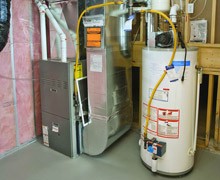My basement is wet; now what?
 Few things can cause more damage to a home than water. Leaks and flooding can cause various structural insufficiencies and may lead to unsafe conditions in a home. Panic often sets in when water enters a home.
Few things can cause more damage to a home than water. Leaks and flooding can cause various structural insufficiencies and may lead to unsafe conditions in a home. Panic often sets in when water enters a home.
Some homeowners live in areas where a high water table inevitably forces groundwater up and into subterranean living spaces. Others may live close to coastal areas or rivers and streams that can overflow and cause home flooding. Still others who may not have had a water problem before learn that a heavy rainfall, and perhaps inadequate drainage outdoors, can cause water damage to a home.
Compounding these issues is the fact that very often a home’s utility systems are located out of the way in basements, or these spaces may be finished to create additional living space. Water in a basement can be much more than a nuisance. Water can lead to thousands of dollars in damage.
Moisture or several inches of water in a basement is nothing to take lightly. Furnaces and water heaters damaged by water can be costly to replace. Wires that come in contact with water can become hazards and cause an electrical fire, and water in a basement may be a harbinger for bacteria and viruses, creating unsanitary living conditions in the home. Mold spores that have developed in a damp basement can spread to other areas of the home thanks to a heating and cooling forced air system. And a cool, damp spot can be the perfect habitat for insects.
When a basement develops a water problem, it is best to call in a professional. Although it might not be cheap, calling a professional can help you to remedy the situation faster than if you try several methods to fix the water problem yourself. When looking for a waterproofing company, seek recommendations from people you trust. Only do business with licensed professional contractors who are willing to give you a free estimate. You also can check out businesses by contacting consumer advocacy groups. You may be able to read up on their business practices and learn if there have been any complaints lodged against a company in the past.
Hydrostatic pressure, poor foundations and cracks can each cause water to enter the house. Each situation is different, and a combination of exterior and interior changes may need to be made. In order to alleviate some water problems, certain modifications must be made. While the following solutions may not be applicable in each situation, they are some of the more common modifications plumbers suggest when fixing flooded basements.
* Sump pump: In some cases, the installation of a well and a submersible pump may be all that’s needed to keep basements dry. When water rises high enough to start the pump, the sump pump will then expel the water out through a pipe to a drain or the street. Sometimes a sump pump works in concert with a French drainage system, which is a channel around the perimeter of the basement that funnels water to the sump pump well.
* Vapor barriers: Vinyl, plastic and paint encapsulation systems may be applied to the interior of foundation walls to serve as a barrier system. This prevents water or condensation from reaching the interior of the house. A vapor barrier may extend below the foundation to direct water runoff into a drainage system.
* Exterior fixes: There are many ways to address flooding from outside the home. These include using outdoor vapor barriers and paints, having grading issues corrected so water will flow away from the home, digging of a swale to catch water away from the basement, exterior drainage systems, and utilizing specialized rain gutters and downspouts to direct water further away from the home during rainstorms.
* Plumbing repairs: Sometimes water issues may be the result of a pipe backup or a faulty appliance and not necessarily an outdoor water issue. In these cases, repairing the source of the leak may be all that’s needed.
